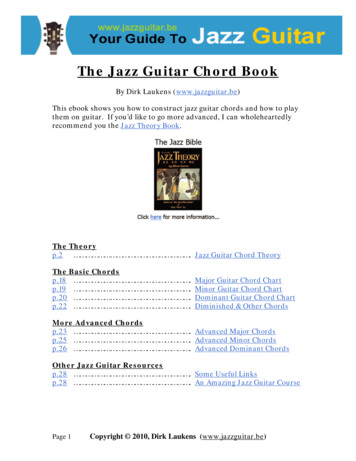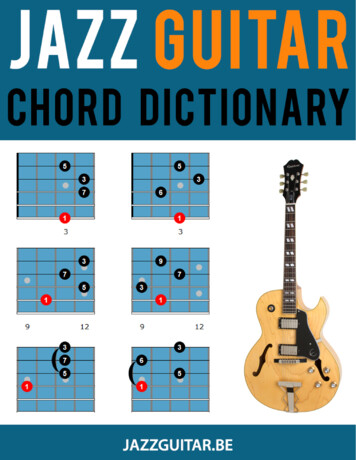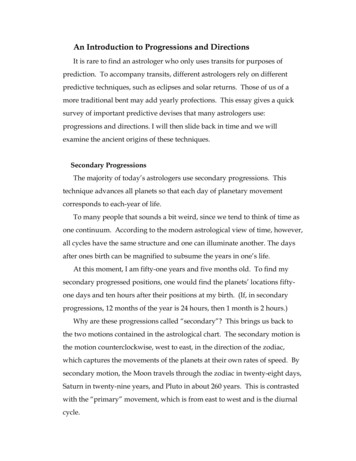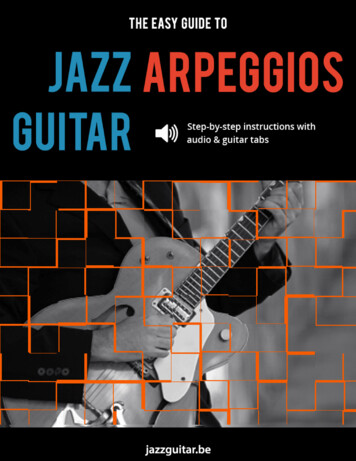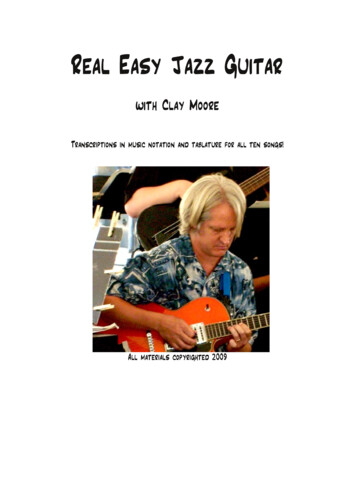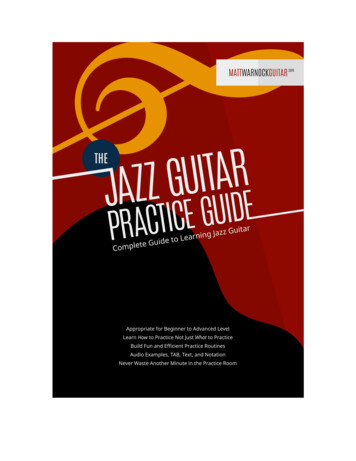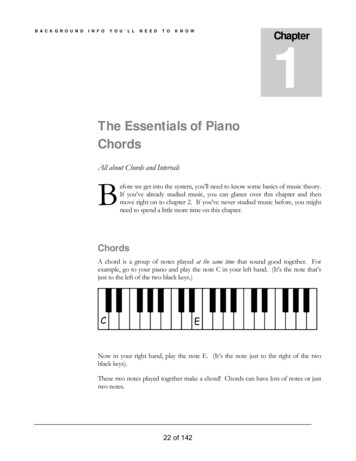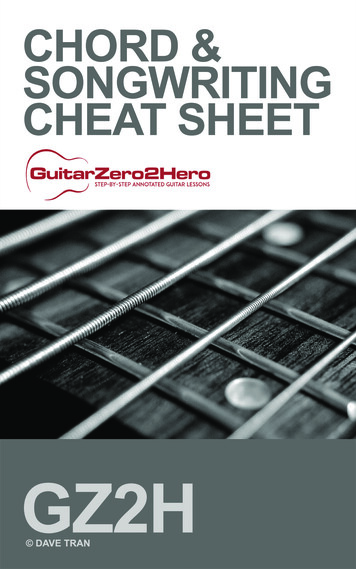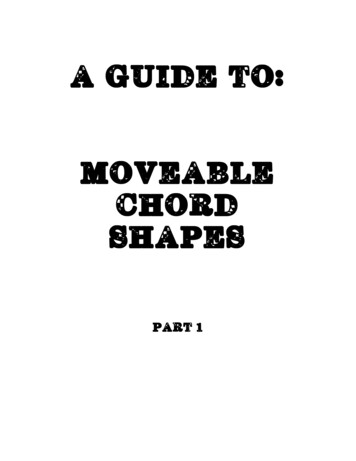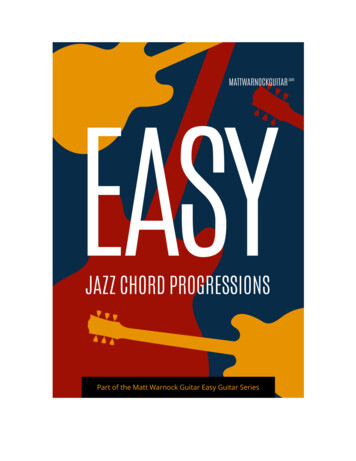
Transcription
Easy Jazz Guitar Progressions12 Essential Progressions for Jazz GuitarWritten By: Matthew WarnockPublished By: Guitar for Life LLCCopyright 2017 Guitar for Life LLCmattwarnockguitar.com2
Table of ContentsHow to Use This eBookIntroduction to Chord ProgressionsMajor ii V I ProgressionMinor ii V I ProgressionMajor I VI ii V ProgressionMinor I bIII ii V ProgressionMixed ii V I 1 ProgressionMixed ii V I 2 ProgressionsBackdoor ii V ProgressionTake the A TrainRhythm Changes BridgeTurnaround to the iim7 ChordIVmaj7 to Imaj7 TurnaroundMinor Clichémattwarnockguitar.com3
How to Use This eBookBefore you dive into this material, take a minute to learn how to get themost out of this eBook in your practice routine.The first thing to know, is that jazz progressions are not usually thoughtof as “easy” as the book’s title suggests.But, with the right practice approach, you can make any progressionsound easy in your comping and soloing.By understanding their construction, and working fun and essentialexercises, any jazz progression can be easy to outline in your playing.The material in this eBook does just this, breaks down seeminglydifficult progressions into easy to understand concepts.Doing so builds your confidence and allows you to outline any of theseprogressions in jazz standards with ease.When learning any progression in this eBook, work it in the followingways to get the most out of your practice time.ØØØØØØLearn the chords in the given key.Work those chords over the backing track.Take those chords to other keys.Learn the single-note material in the given key.Take that material to soloing over the backing track.Work the single-note material in other keys.Working progressions this way teaches you to recognize these changesin jazz tunes and outline them with confidence.This is why the first part of any chapter is often the most important.mattwarnockguitar.com4
It’s no good to have a ton of great chords or licks over a backdoor ii V I ifyou can’t recognize that progression in a tune, for example.Recognizing the progressions in a jazz standard is the first step to beingable to comp or solo over those changes with confidence.Because of this, don’t skip the intro theory to jump into the chords andsoloing material.As you learn these chord progressions, take out your Real Book and seeif you can find those changes in jazz tunes.This is a powerful complimentary exercise to the material in this eBook.With that said, you’re ready to learn these essential jazz chordprogressions on guitar.About the Backing TracksFor some of the progressions below, you can play them as 2 or 4-barphrases.Because of this, the material is presented in both of those lengths.When this happens, the backing tracks are the 4-bar versions.This allows you to stretch out, take your time, and work the materialuntil it’s comfortable and confident.Any of the 2-bar material can also be played over the 4-bar backingtrack; you just need to adjust the rhythms.mattwarnockguitar.com5
Introduction to Chord ProgressionsBefore digging into the essential progressions, take a few minutes tolearn or review how progressions are constructed.Chord progressions are built by mixing diatonic and non-diatonicchords based around the tonic key of the song.Those chords are built by stacking notes on top of any note in thediatonic scale, or borrowed scale in the case of non-diatonic chords.As progressions are built by adding chords to each note in a scale, thefirst thing to know is the notes/degrees of any major scale.The same thing can be done for minor scales, but to keep things simpleyou look at major progressions in these examples.Here’s a C major scale written with a 5th-string bass note.The letter names and scale degree numbers are written below each notein the scale.Scale degrees will be very important going forward, so keep a close eyeon those.Lastly, when talking about single-notes, scale degrees for example, youuse Arabic numerals, 1-2-3-4-5, etc.Then, for chord numbers you use Roman numerals, I-ii-iii-IV-V, etc.This lets you quickly understand which one someone is talking aboutwhen referring to either single-notes or chords.mattwarnockguitar.com6
To make things easier to build chords under these scale notes, you putthe scale on one string.You can see this here with the C major scale written on the 5th string.Once you have the notes in a key on one string, you can add chords toeach one of those notes.For every major scale, no matter the key, you use the following m7b5Here are sample chords for all the changes in the key of C major.mattwarnockguitar.com7
If you were to take these chords to the key of G major, for example, itwould all be the same order, just different notes.In G major it would be Gmaj7, Am7, Bm7, Cmaj7, D7, Em7, and F#m7b5.Now that you have the diatonic chords worked out, you can arrangethem in a new order to create progressions.Here’s an example of the C major chords in the first line, as well as acommon progression in the second line.To build that progression, you take the I, vi, ii, V, and iii chords from Cmajor and arrange them into the progression below.All diatonic progressions are built this way; you figure out the chords ina key and then match those chords to the numbers in the progression.mattwarnockguitar.com8
Non-Diatonic ChordsBesides seeing chords from the key you’re in, you also see non-diatonicchords in popular jazz progressions.While these chords are temporarily outside the key, they can be labeledand thought of as variations of diatonic chords.You see this in the example below with the ivm7 bVII7 chords in a Cmajor progression.Normally those chords are Fmaj7 (IVmaj7) and Bm7b5 (viim7b5) in thekey of C.While Fm7 and Bb7 aren’t in the key of C, they’re leading to a Cmaj7chord, and are only being sounded for one bar each.mattwarnockguitar.com9
Though they aren’t in C, they’re only temporarily outside the key, andthey jump back to C major right away.Because of this, it’s easier to think of them as variations of chords in Cmajor, rather than a new key for such a short amount of time.Secondary Dominant ChordsYou also encounter secondary dominant chords in this eBook.These are 7th chords that you find in jazz songs that aren’t the V7 of thetonic key.The most famous example is the V7/V7 chord, also called II7, as it’s adominant built from the second note of the scale.Secondary dominants are used to create tension and strongermovement to a diatonic chord that’s not the tonic.The V7/V7 example below, taken from Take the A Train, shows a D7 inbars 3 and 4.Here, D7 is the V7 of G7, the V7 of Cmaj7; therefore it’s the V7/V7.mattwarnockguitar.com10
If this is confusing, not to worry, just know that you will see 7th chordsin jazz that aren’t the V7.Most of the time, by far, those chords are the V7 of another diatonicchord, such as the V7/iim7, V7/vim7, or V7/V7.Here’s that Take the A Train example to check out before digging intosecondary dominant chords further in the progressions below.mattwarnockguitar.com11
Major ii V I ProgressionAs it’s the most famous progression in jazz, the major ii V I is the first setof changes you study in this eBook.This progression is found in countless jazz standards, and it’s the mostessential progression to practice for any jazz guitarist.Below, you work on 2 and 4 bar versions of this progression, as you dofor many progressions in this eBook.The backing track is the 4-bar version to keep things spread out andslowed down when practicing.But, any 2 bar material can be applied to the 4-bar version and viceversa, you just need to speed up or slow down to fit the phrase.Building the ProgressionTo build the progression, you take the 2nd, 5th, and 1st chords from thekey of C major and play them in that order.Here’s a harmonized C major scale with the Roman numerals for eachchord written below the changes.From there, you can see how you take the 2nd, 5th, and 1st chords, Dm7G7-Cmaj7, to form the ii V I progression.mattwarnockguitar.com12
Comping ExercisesNow that you know how to build this progression, here are chordexercises to take those shapes onto the fretboard.The first group of chords brings 9 and 6 colors to the G7 and Cmaj7chords respectively.Each chord in this eBook is written with a plain rhythm to make it easierto learn.After you learn these shapes, experiment with various rhythms as youtake these chords to the backing track.mattwarnockguitar.com13
Audio Example 1In this chord phrase you bring m9, 13, and 6/9 colors to each change inthe progression.Make sure to work these, and all chords, in 12 keys as you take themaround the fretboard in your studies.Audio Example 2To take these chords further, here are four positions of drop 2 chordsthat use voice leading to outline the major ii V I.Here, you start by playing an inversion of Dm7, then you lower the b7 ofthat Dm7 chord by one fret, C to B, to form a rootless G9 chord.mattwarnockguitar.com14
Any time you have a ii V progression, you can play the iim7 chord, lowerthe b7 by one fret, and you get a V9 chord without a root.Check out these shapes and have fun with these jazzy sounding ii V I’s.Audio Example 34 Chord LicksHere are 4 chord licks to learn over the major ii V I, and then add themto your comping, chord soloing, and chord melody playing.The first line is an Ed Bickert style line that uses syncopation anddifferent chord colors to create interest over the progression.mattwarnockguitar.com15
Audio Example 4This is a busier Joe Pass inspired line that uses a number of chord colorsover the written shapes.If these chords are new to you, write them out on a separate sheet ofpaper to start building your chord dictionary.As you learn new shapes that you like, add them to your chorddictionary until you build a solid vocabulary of colorful chords.Audio Example 5mattwarnockguitar.com16
Here, you use three-note chords, no roots, to outline the changes.Often fast-moving chords are easier to outline with smaller shapes, suchas these.Working up a few chord lines that use smaller shapes prepares you toapply them to fast-moving chords or tunes played at fast tempos.Audio Example 6These three-note chords bring some color to the underlying changes.Don’t forget to take this, and other, chord line to other keys in yourpractice routine.Audio Example 7mattwarnockguitar.com17
Arpeggio ExercisesYou now work on soloing over the major ii V I progression, beginningwith arpeggios.Here are four positions of one-octave arpeggios over those changes.Each of these positions is written up, down, and alternating todemonstrate those variations over these changes.These variations won’t be written out again in the eBook, or else thebook would be 500-pages long.So, study these variations, and as you move on to other progressions,always work arpeggios and scales up, down, and alternating.This teaches you the shapes, as well as gets you away from alwaysstarting on the root when soloing with arpeggios.Audio Example 8mattwarnockguitar.com18
Here are the descending versions of the arpeggios to study.Audio Example 9Here are the alternating versions of the arpeggios to explore.mattwarnockguitar.com19
Audio Example 10Here are the two-octave arpeggios for each chord in a major ii V I.Once you can play them from memory up, work them down, andalternating to get the most out of these shapes.And, don’t forget to solo with these shapes over the backing track to addthem to your improvisations.mattwarnockguitar.com20
Audio Example 11Scale ExercisesBecause you can outline all three chords in a major ii V I with the majorscale, you’ll challenge yourself with new scales in this section.For each chord in the progression, you use the related bebop scale,minor bebop, dominant bebop, and major bebop.These bebop scales are built by adding one chromatic note to a majormode, like so.Ø Minor Bebop Dorian with added 7Ø Dominant Bebop Mixolydian with added 7Ø Major Bebop Major with added b6mattwarnockguitar.com21
Here are those scales in two positions on the guitar to learn and add toyour solos.Start by learning one bebop scale, probably minor, and soloing with thatscale over the Dm7 chord, leaving the rest blank.Then, add the dominant bebop scale and leave the maj7 chord blank.Finally play all three scales as you build up to outlining every chord in amajor ii V I with its related bebop scale.Audio Example 12As you work through this eBook, you learn scales and arpeggiosseparately over each progression.But, once you have those down you can also combine them to take theseconcepts further in your playing.mattwarnockguitar.com22
Here are four positions of playing the arpeggio up and scale down foreach chord in the major ii V I progression.For each one you play up the 1357 arpeggio and down the bebop scalefor each chord.After you can play these exercises, take them to other progressions inthis eBook if you want that extra challenge.You don’t have to work arpeggios and scales together like this, but itdoes challenge your fretboard knowledge and technique on the guitar.Audio Example 13mattwarnockguitar.com23
4 Single Note LicksTo help you take these technical items to a musical situation, here arefour major ii V I licks to learn and add to your solos.The first lick is a bebop line that mixes arpeggios, scales and chromaticnotes to build a slippery sounding phrase over the chords.Audio Example 14In this line, you mix scales, arpeggios, and passing notes to create a fourbar major ii V I phrase.Audio Example 15mattwarnockguitar.com24
Here’s a lick that alternates an arpeggio up and scale down over the ii Vthat resolves to the 3rd of Cmaj7.Playing the arpeggio up and scale down is a common bebop exercise, sowork this concept in other positions to take it further in your playing.Audio Example 16The last lick uses alternating arpeggios, this time starting withdescending, to outline the changes.After you
progressions in jazz standards with ease. When learning any progression in this eBook, work it in the following ways to get the most out of your practice time. Ø Learn the chords in the given key. Ø Work those chords over the backing track. Ø Take those chords to

